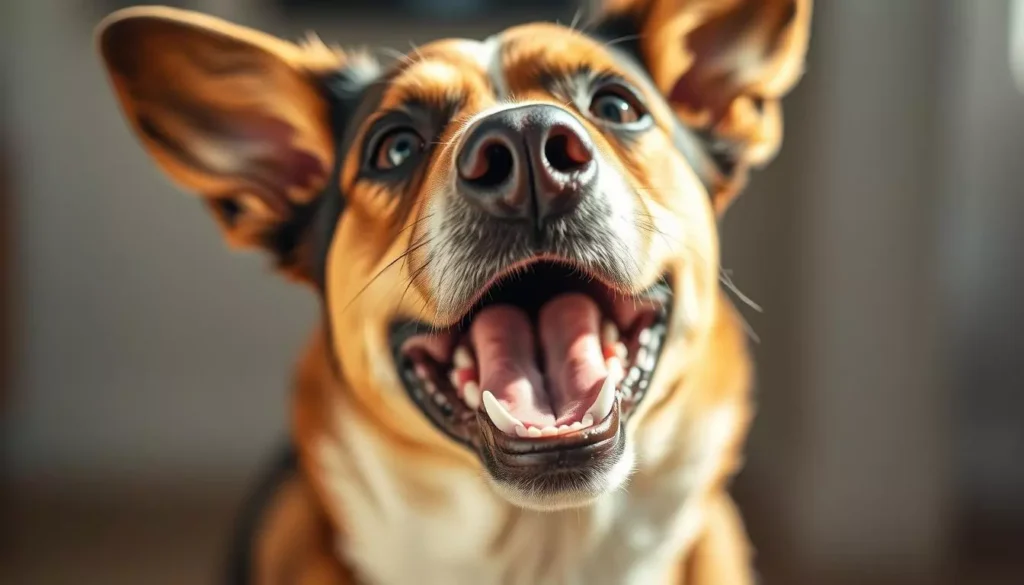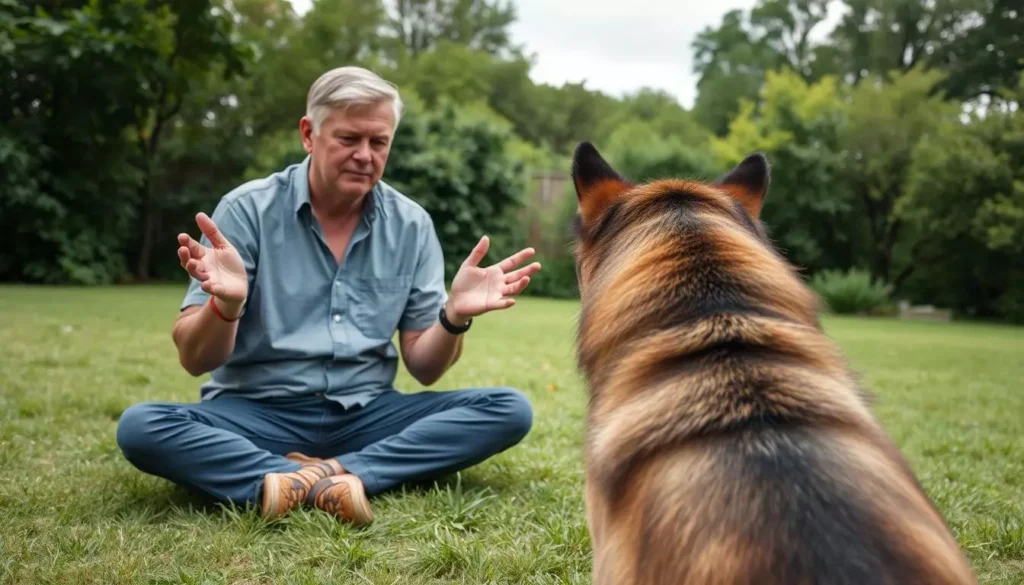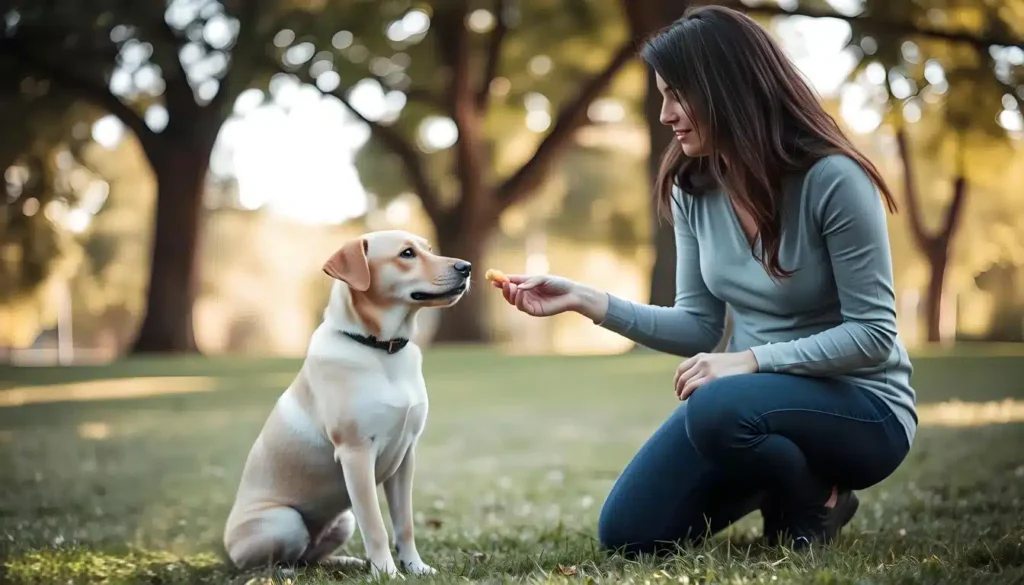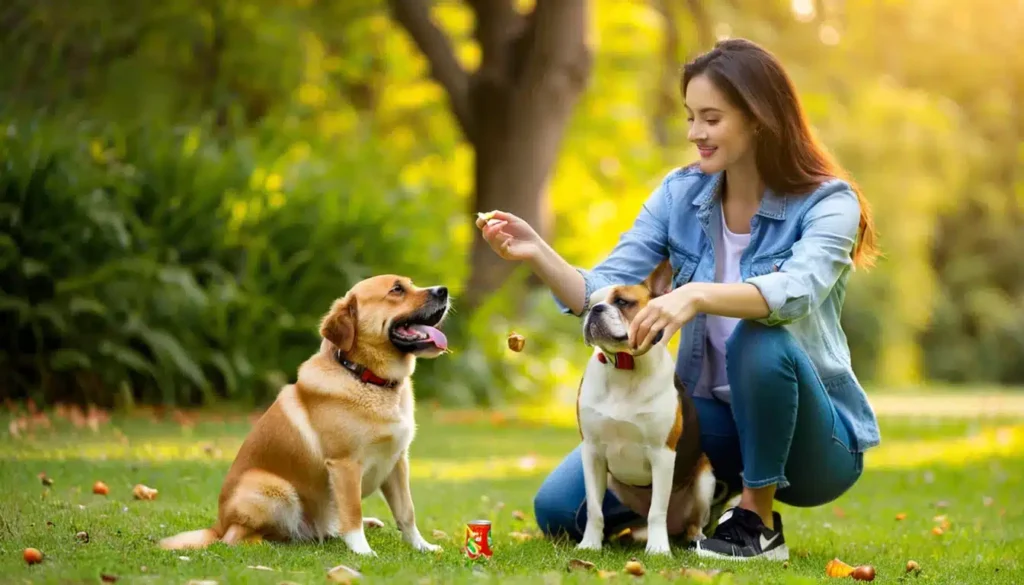Every dog owner has felt uneasy when their dog growls. It's not just a sound; it shows what our dogs are feeling. When my dog growled at me for the first time, it scared me. Was he mad, scared, or just playing?
Knowing what dog growls mean is key to a strong bond with our pets. In this guide, I'll share what to do when your dog growls. We'll look at different growling behaviors and offer tips to handle them.
Key Takeaways
- Understanding growls is essential for effective communication with your dog.
- Identify the context behind your dog's growling behavior.
- Stay calm when responding to your dog's growls.
- Teach alternative behaviors to reduce unwanted growling.
- Avoid punishment or ignoring your dog's growl.
Understanding Dog Growls
Dog growls are key in how dogs talk to each other. They show different feelings and needs in various situations. For example, a growl can mean fun during play, discomfort when scared, or protection when something new appears.
Knowing what dog growls mean is very important for dog owners. It helps us understand what our dogs are feeling and thinking.
By recognizing growling signals, we can talk better with our dogs and avoid misunderstandings. Sometimes, a growl might seem scary, but it usually means something important. Knowing the context and what the growl means can help us connect deeper with our pets.
Watching these sounds and body language helps us respond in the right way. This strengthens our bond with our dogs.
By listening to our dog's growls and watching their actions, we can make our relationship with them happier and more peaceful.
Types of Dog Growls
Knowing the different types of dog growls is key for pet owners. Each growl means something unique and shows a dog's feelings. By understanding these growls, we can better connect with our dogs.
Play Growls
Play growls are light and friendly, showing a dog is relaxed. They happen during fun times, like when dogs play together or with their owners. Hearing these growls means your dog is having a good time.
Warning Growls
Warning growls mean a dog might feel scared or threatened. They come with stiff body language, warning of possible trouble. Spotting these growls helps avoid fights by giving dogs the space they need.
Stress Growls
Stress growls show a dog is feeling anxious or scared. They can happen during vet visits, loud noises, or new places. Paying attention to these growls helps us understand our dog's feelings. It's important to address what's causing their stress for their happiness.
Why Do Dogs Growl?
Dogs have a unique way of talking to us, and growling is a big part of it. Knowing why dogs growl helps keep them happy and safe. I often wonder, why does my dog growl? This makes me look into all the growling reasons out there.
Growling can mean a dog is having fun, like during a game. It's usually with a wagging tail and a happy look. But, it can also mean a dog is stressed or scared, especially if they feel threatened. Knowing this helps me understand what my dog needs.
Growling can also show a dog is scared or trying to be in charge. Getting to know these feelings helps me connect better with my dog. By watching their body language and sounds, I can understand what they're trying to say.
Recognizing Different Growls
It's key for dog owners to know the difference between happy and aggressive growls. By understanding these growls, I can react in the right way. This ensures a good relationship with my dog.
Happy Growls versus Aggressive Growls
Happy growls happen when my dog is playing and feeling happy. These growls come with playful signs like a wagging tail and a calm body. On the other hand, aggressive growls show my dog is upset or warning me. They have a stiff body, bared teeth, and a still tail.
Pay attention to these signs to better connect with my dog. It's not just the sound that matters. The body language is just as important. Knowing these signals helps keep our home peaceful.

What to Do When Your Dog Growls at You
Dealing with growls can be confusing for dog owners. It's key to understand the situation and respond right. Acting fast can stop problems from getting worse. Here's what I do when my dog growls.
Assessing the Situation
Understanding growls starts with knowing the situation. I watch the context of the growl. Finding out what triggers it, like other animals or sudden moves, helps me see how my dog feels. This is important for handling growls and keeping things calm.
Responding Calmly
When my dog growls, I stay calm. A calm approach helps reduce tension. I avoid sudden moves or loud voices, as they can make things worse. By staying calm, I help my dog feel safe, leading to better interactions.
Teaching Alternative Behaviors
Teaching my dog new behaviors is key. I use positive reinforcement, rewarding calm actions. This replaces aggressive behaviors with better ones. Over time, my dog learns what's okay, making our relationship better.
Common Triggers of Growling
Growling in dogs can be a worry, but knowing what causes it helps a lot. Dogs growl for many reasons, like when they meet other dogs or when they're upset. They might also growl if they feel someone is taking their food or toys.
Loud sounds, like thunderstorms or fireworks, can make dogs anxious. This anxiety can lead to growling as a way for them to cope with stress.
Knowing what makes my dog growl helps me find ways to keep them calm. By understanding why they growl, I can reduce stress for both of us. Watching how they act when they growl tells me a lot about how they're feeling.

Resource Guarding and Growling
When I see my dog guarding food or toys, I know it's resource guarding. This natural behavior can cause problems with people or other pets. It's key for dog owners to understand this to keep peace at home.
Understanding Resource Guarding
Resource guarding is about protecting valuable things. Dogs might guard food, toys, or even where they sleep. Knowing why they do this helps me handle situations before things get worse.
Signs of Resource Guarding
Spotting guarding signs is important. Look out for:
- Growling when approached while eating or playing
- Stiff posture and eye contact
- Defensive vocalizations, often low and meant to deter interactions
Being alert to these signs helps avoid trouble. Spotting resource guarding early lets me act fast. This keeps everyone safe and makes my dog feel secure.
How to Handle Growling in Different Situations
Understanding and addressing growling in various contexts can greatly improve my bond with my dog. Each situation calls for a specific approach to keep us both comfortable and safe. I'll look at how to handle growling during play, when meeting another dog, and over food or toys.
Growling During Playtime
Growling during play is common and usually means my dog is excited and enjoying the moment. I watch for signs like wagging tails and relaxed ears to know he's having fun. This helps us play safely and enjoyably together.
Growling When Approaching a Dog
Growling when meeting a dog often means they want space. It's a clear sign to respect their boundaries. I keep a safe distance to avoid any issues and ensure the dog feels secure.
Growling Over Food and Toys
Growling over food or toys shows my dog feels protective of their belongings. It's crucial to manage these resources carefully. I teach my dog to see me as a positive influence, not a threat. By gradually introducing sharing, I help reduce growling and create a more peaceful environment.

| Situation | Key Signs | Handling Techniques |
|---|---|---|
| Playtime | Excitement signals, wagging tail | Encourage positive play, watch body language |
| Approaching Another Dog | Growling, stiff posture | Respect space, avoid forcing interaction |
| Food and Toys | Snapping, protective stance | Create safe sharing, teach calm behaviors |
What Not to Do With a Growling Dog
When a dog growls, it's important to know what not to do. Misunderstanding can make things worse. Here are two key points: don't punish growls and don't ignore them.
Avoiding Punishment
Punishing a growling dog is a big mistake. Growls are a warning that something is wrong. Punishing them can teach the dog to hide its feelings, leading to aggression.
This can cause confusion and make the dog more anxious. It's better to see growls as a way for dogs to communicate. This way, we can create a safer and more understanding environment.
Ignoring the Growl
Ignoring a growl is also a mistake. Not paying attention to growls can mean missing out on understanding our dog's feelings. By ignoring them, we don't solve the problem causing the dog's discomfort.
It's crucial to figure out what's wrong and respond in a way that helps. This approach can reduce tension and improve communication with our dogs.
Training Techniques to Reduce Growling
Dealing with growling in dogs can be tough. I've found that good training makes a big difference. Positive reinforcement training helps my dog behave better instead of growling.
Basic commands like "sit" or "stay" work well with treats or praise. This makes my pet more obedient and less likely to bark.
Behavior modification is key in reducing growling. I identify what makes my dog growl and work on desensitization. For instance, if he growls at other dogs, I expose him to calm dogs in a safe setting.
This helps him learn to react well. Counterconditioning boosts positive reinforcement training. When my dog enjoys something, like treats, during a trigger, his growling goes down.
Seeking Professional Help
Dealing with persistent growling in dogs can be tough. At this stage, getting professional help for dog behavior is wise. Certified trainers and behavior consultants can create custom plans. They help figure out and fix the underlying reasons for the growling.
Professional help lets me learn special training methods for my dog. Whether it's fear or resource guarding, experts can explain it. They teach us how to improve our relationship with our dogs.
Spending time with a behavior consultant helps me understand my dog better. It also strengthens our bond. With their guidance, we can tackle the growling's root causes. Knowing help is out there makes a big difference.
Working with experts helps us move forward. It makes our relationship with our dogs better. Getting help is a smart move, especially for dealing with anxiety or aggression.
Creating a Positive Environment for Your Dog
Creating a positive environment for your dog is key to reducing growling. When I focus on making my dog comfortable, I see a big drop in their anxiety. A calm space for dogs can be made in many ways, all aimed at their safety and happiness.
One important thing is making sure their area is safe and welcoming. This means comfy beds, fun toys, and room to move around. Regular routines help them feel secure by removing uncertainty. Keeping their feeding and play times the same also helps keep things calm.
It's also vital to spend quality time with your dog. Playing and training together builds a strong bond of trust. By understanding their body language and reacting well, we encourage good behavior and improve their environment.
| Strategy | Description |
|---|---|
| Comfortable Bedding | Soft, supportive beds help dogs feel secure while resting. |
| Interactive Toys | Stimulating toys keep dogs mentally engaged and reduce boredom. |
| Regular Routines | Consistent schedules create a sense of predictability, lowering anxiety. |
| Positive Interactions | Quality time spent with dogs strengthens the bond and enhances trust. |
In short, a positive environment for dogs not only cuts down on growling but also boosts their happiness. By making sure their space is calm and loving, I ensure my dog feels safe and cherished at home.
Understanding Body Language and Stress Signals
It's key for dog owners to understand dog behavior. Knowing how to read dog body language helps me see how my dog feels. This way, I can meet their needs better. Spotting stress signals in dogs is especially important before they growl.
Some common signs include:
- Lowered ears, which may signal fear or submission
- A stiff posture, indicating discomfort or aggression
- Avoiding eye contact, which can show anxiety
By noticing these stress signals, I can act fast. This might prevent growling. Talking to a dog showing these signs helps them feel better. It also strengthens our bond.
Conclusion
As I finish my summary on dog growls, it's clear that understanding this behavior is key for dog owners. Knowing the different types of growls helps me tell playful barks from warning signs. This is crucial for managing my dog's behavior well.
By recognizing stress cues and encouraging positive communication, we can have a better relationship. This makes our time together more enjoyable and peaceful.
Growling is more than just a sound; it's a way for dogs to communicate. By learning to understand my dog's sounds and body language, we can create a safer space. This way, we can avoid growling issues and strengthen our bond.
In the end, being proactive about growling behavior is essential for a happy dog-human partnership. By paying attention to my dog's needs and responding to them, we can have a fulfilling and stress-free life together.




